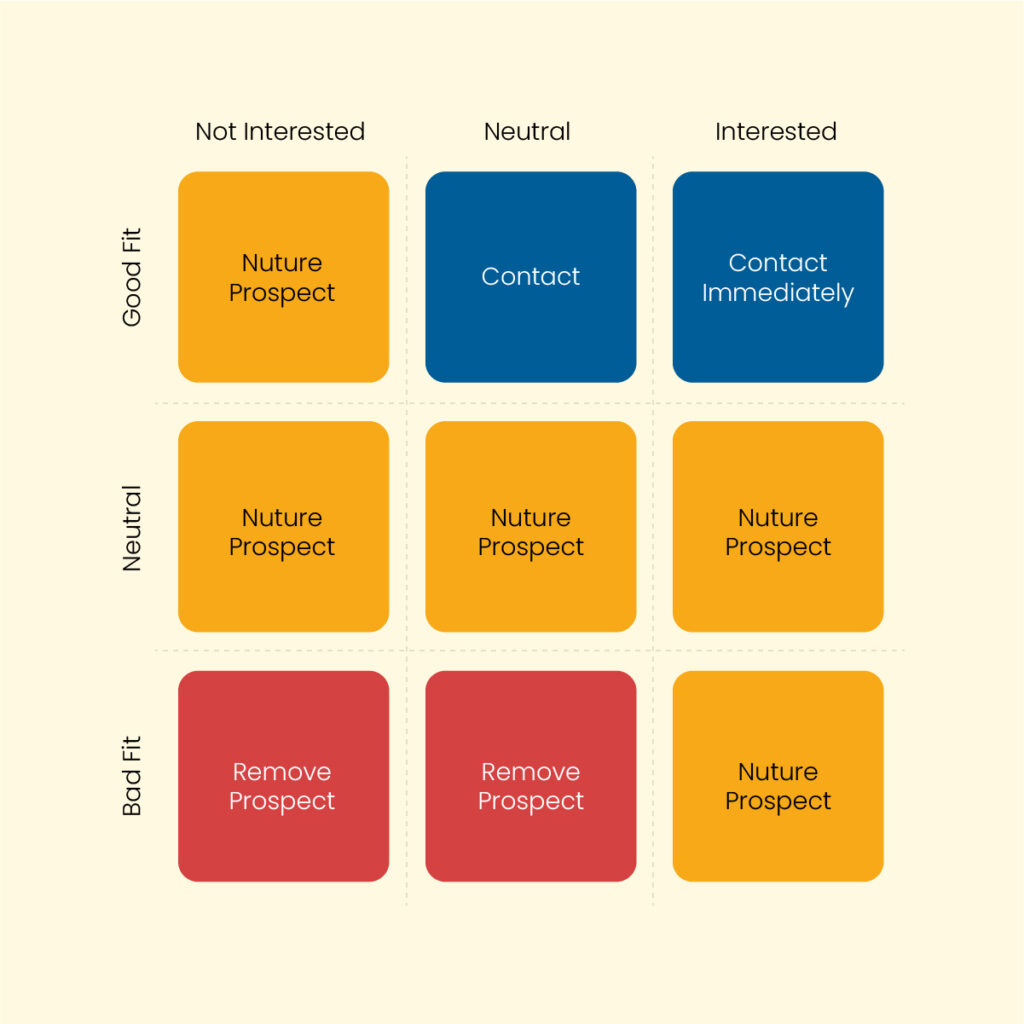
A Sales Matrix can help sales teams focus their resources on opportunities with the highest potential, improving both efficiency and sales outcomes. It can help businesses determine which clients are worth pursuing based on factors such as customer receptiveness and alignment with the business’s offerings.
At its core, a Sales Matrix is designed to evaluate the urgency and viability of sales opportunities. It does this by comparing a prospect’s willingness to engage with the products or services a business offers, identifying areas where there is significant overlap. This allows sales teams to better coordinate their outreach efforts, ensuring that they target the right prospects at the right time. As a result, the Sales Matrix not only improves the effectiveness of customer interactions but also maximizes the return on investment for sales activities.
It’s important to accurately gauge customer interest and receptiveness, as well as to evaluate how well your offerings align with customer needs. Additionally, the matrix should be adaptable, allowing for adjustments as market conditions and customer preferences change. By carefully designing and implementing a Sales Matrix, businesses can create a powerful tool that drives sales growth and improves overall efficiency. In this blog, we aim to learn what a Sales Matrix is, what factors must be considered to ensure it meets your business’s specific needs, as well as how to create one as a beginner.
What is a Sales Matrix?
A Sales Matrix is a tool used by sales teams to measure the potential of prospects. To simplify it, the sales matrix focuses on two crucial attributes: fit and interest. This allows companies to prioritize their efforts on those leads who are interested in the company’s offerings and are a good match for their products or services. Such an approach is helpful to get more conversions.
The sales matrix simplifies the process of determining which leads deserve the most attention By evaluating how well a prospect aligns with the company’s offerings, the sales teams can focus their outreach on prospects who are more likely to convert.
You can now navigate the more complex sales landscape with greater clarity, ensuring that your resources are invested in the right opportunities at the right time. This method is especially valuable in inbound prospecting, where understanding a prospect’s readiness and suitability is key to making strategic decisions about lead prioritization.
One of the critical components of a Sales Matrix is the “fit” criterion. This element evaluates whether a prospect meets the practical requirements that align with the business’s offerings, such as industry type, company size, revenue, and decision-making authority.
By focusing on these factors, companies can identify leads that are more likely to benefit from their products or services. This ensures that sales teams are targeting prospects where their efforts are most likely to pay off, leading to more successful sales engagements and a higher return on investment.
The second criterion is “Interest”. While a prospect may align well with your company’s product in theory, their level of interest is crucial in determining the likelihood of a sale. A high-fit prospect with low interest might require nurturing and engagement to build their interest, whereas a high-interest, low-fit prospect may need a different approach.
Balancing these two factors allows businesses to refine their sales strategies, ensuring they pursue leads that not only match their offerings but are also genuinely interested in what they provide.

📖 You May Also Like Top 20 SDR Strategies for Scaling Sales
Why Make a Sales Matrix?
Creating a Sales Matrix is crucial for businesses aiming to optimize their prospecting efforts and focus on the most promising leads. This tool helps you evaluate not only whether a prospect fits your product or service but also whether they show genuine interest in your business.
By using a Sales Matrix, you can prioritize prospects who are most likely to convert, ensuring your time and resources are invested where they’ll have the greatest impact. This strategic approach to lead management helps you make better decisions about which prospects to pursue, nurture, or eliminate from your pipeline.
One of the key benefits of a Sales Matrix is its ability to assess interest, a factor often overlooked in traditional prospecting. While it’s relatively easy to determine if a prospect fits your product by looking at industry, company size, or revenue, understanding their interest requires a deeper dive. This is where inbound prospecting tools come into play.
For instance, tracking website visits can provide valuable insights into a prospect’s engagement level. A company that has visited your website multiple times is likely more open to doing business with you than one that has never interacted with your brand.
Let us learn using a fictional scenario where two prospective companies, ABCD & Co. and XYZ Industries, are being evaluated. ABCD & Co. has visited your website frequently, exploring multiple pages, while XYZ Industries has shown no interest. Even if both companies are a good fit, ABCD Corp should be your top priority due to their demonstrated interest.
Without a Sales Matrix and the ability to track interest, you might waste valuable time on leads that aren’t genuinely interested, missing out on opportunities that are more likely to convert.
The Sales Matrix also helps you determine the next steps for prospects who don’t immediately stand out. For those who fit your product but show little interest, nurturing campaigns can be developed to build engagement over time.
Similarly, prospects that neither fit your product nor show interest can be deprioritized or removed from your pipeline. This ensures that your sales team focuses on the leads with the highest potential, improving efficiency and boosting your overall conversion rates.
Therefore, a Sales Matrix empowers your business to work smarter by combining fit and interest into a cohesive strategy. By aligning your sales efforts with both factors, you can ensure that your outreach is targeted and effective.
This approach not only helps you avoid the frustration of chasing uninterested leads but also maximizes your chances of closing deals with prospects who are genuinely interested in what you offer.
Feel the Power of a CRM Software
Get your free trial of Office24by7 CRM software and win exciting offers to get a custom pricing for your tailored product.
What to Keep in Mind When Building a Matrix for Prospects?
When building a Sales Matrix for prospects, it’s important to tailor your approach depending on whether you’re targeting new or existing customers.
For new prospects, it’s crucial to understand and speak their language. Different businesses may use specific acronyms, buzzwords, or tools, so aligning your communication with their terminology is essential. This helps you position yourself as a knowledgeable salesperson who understands their needs.
Additionally, consider whether your values and objectives align with theirs and if your solution can effectively address their challenges. This alignment is key to establishing trust and making a strong first impression.
Identifying key events that might influence a prospect’s decision to purchase is another vital aspect of building a Sales Matrix. Consider any pain points or challenges the prospect might be facing that your product or service can solve. Understanding the timing and impact of these events, as well as identifying the decision-makers who will be most affected, will help you tailor your approach.
Listing the leaders, influencers, and those most likely to engage with your offering allows you to target your efforts more effectively, increasing the chances of a successful sale.
Total cost analysis is another critical factor to keep in mind when building your Sales Matrix. It’s important to consider all the costs associated with your product, not just the initial purchase price. This includes installation, training, ongoing support, and any hardware or software requirements.
Being transparent about these additional costs in your communications helps avoid any surprises for your prospects, building trust and setting clear expectations. A well-rounded cost analysis ensures that both you and the prospect have a complete understanding of what the partnership will entail.
Finally, consider your business’s capacity to invest in new prospects without overstretching your resources. It’s essential to balance your efforts between growing in a new market and maintaining strong relationships with existing clients.
For example, if a new prospect could potentially bring in significant growth, you might allocate a proportionate amount of your resources, such as an 80/20 split between existing and new prospects. This balance ensures that your team can effectively manage the workload and that your business can grow sustainably without compromising current client relationships.
What to Keep in Mind When Building a Matrix for Existing Customers?
When building a Sales Matrix for existing customers, it’s important to recognize that it’s never too late to reevaluate your approach. Even if you’ve had a longstanding relationship with a client, creating or revising a Sales Matrix can help you better understand their evolving needs and identify new growth opportunities.
While the process is similar to building a matrix for new customers, it requires some adjustments to account for the existing relationship. By revisiting your customers’ profiles and updating your matrix, you can continue to align your offerings with their current and future needs.
Start by considering all the products and services your business offers and how they relate to each of your existing clients. Categorize your clients based on key factors like industry, size, location, and the products they currently purchase from you. This categorization allows you to fit each client into your Sales Matrix, matching them with the solutions that best meet their needs.
By doing so, you can more effectively identify opportunities for cross-selling or upselling, ensuring that your clients are aware of all the ways your business can support them.
Once your existing clients are mapped within your Sales Matrix, you can begin to pinpoint who would benefit most from additional services or products. For example, a client already purchasing one of your solutions might find significant value in a complementary service you offer.
This strategic approach allows you to tailor your outreach to existing customers based on their specific needs and potential pain points, increasing the likelihood of further engagement and satisfaction. At the same time, you can also determine which clients may not need additional products or services, helping you avoid overextending your efforts.
Lastly, it’s important to balance your focus between nurturing existing relationships and exploring new opportunities. By continuously updating your sales matrix, you can stay attuned to your clients’ evolving needs, ensuring they receive the most relevant and beneficial services. This not only strengthens your relationships but also helps you identify areas where your offerings can grow alongside your clients. By keeping a well-maintained matrix for existing customers, you can drive long-term success and maintain a competitive edge in the market.
💡 Try This To Learn More Sales CRM: How It Can Benefit Your Business?
Step-by-Step Guide to Creating Your Own Sales Matrix
Creating a Sales Matrix is a straightforward process that will help you better understand and prioritize your leads. Follow this simple, step-by-step guide to build your own Sales Matrix and start converting more prospects into customers.
Step 1: Define Your Ideal Customer Profile (ICP)
Begin by identifying the key characteristics that define your ideal customer. Consider factors such as industry, company size, job title, and common pain points. With these details, create a detailed profile that outlines your ideal customer’s needs, challenges, and goals. This profile will serve as a foundation for evaluating how well prospects align with your target market.
The Office24by7 sales CRM’s robust data management features allow you to track and store detailed information about your prospects, including industry, company size, and specific pain points. This centralized database ensures that all team members have access to consistent and accurate profiles in the future.
Step 2: Establish Interest Levels
Next, create a scoring system to measure the level of interest a prospect has in your company or products. This can include factors like website visits, content downloads, email engagement, and social media interactions. Then, divide your scoring system into tiers—high, medium, and low—to categorize prospects based on their interest levels. This step helps you gauge how engaged and ready each prospect is to move forward.
The sales automation of Office24by7 enables auto-update of lead details based on their activities. The built-in lead scoring system ensures that you focus on the most promising leads, enhancing your chances of closing deals faster.
Step 3: Evaluate Fit
Now, develop a scoring system to evaluate how well a prospect fits your Ideal Customer Profile (ICP). Look at aspects like industry, company size, job title, and how closely they align with your target market. Just like with interest, divide your fit scores into tiers—excellent, good, and poor. This will allow you to easily see which prospects are the best matches for your offerings.
Step 4: Create the Matrix
With your interest and fit tiers in hand, design the layout of your Sales Matrix. Set up a two-dimensional grid with interest levels on one axis and fit levels on the other. Label the axes clearly so that you can easily categorize prospects based on these two criteria. This matrix will visually map out where each prospect stands, helping you to prioritize your efforts.
Step 5: Populate the Matrix
It’s time to place your prospects into the matrix. Position each one within the grid based on their interest level and fit score. For clarity, you might consider using color coding to represent different levels of interest and fit. This visual aid makes it easy to identify your top prospects at a glance.
Step 6: Prioritize Prospects
Focus your attention on the prospects that fall into the “high interest” and “excellent fit” quadrant of your matrix. These are your most promising leads and should be your top priority. For prospects in other quadrants, develop a nurturing strategy to engage them further based on their level of interest and fit.
Office24by7 Sales CRM’s lead management features empower you to prioritize prospects effectively within your Sales Matrix. The CRM allows you to set alerts and reminders for high-value prospects, ensuring that no opportunity slips through even when you handle multiple leads in various stages of longer sales cycles.
Step 7: Continuously Update and Refine
Your Sales Matrix is not a static tool—it should evolve as your prospects’ interest and fit change over time. Regularly update your matrix to reflect these changes and use the insights you gain to refine your Ideal Customer Profile (ICP). This continuous improvement will help you stay aligned with market trends and maintain a sharp focus on the best opportunities.
By following these steps, you can create an effective Sales Matrix that helps you prioritize leads, allocate resources efficiently, and increase your chances of converting prospects into loyal customers.
Get a Great Call Center Set Up For Your Business!
All the favorite features with a great interface at affordable rates for businesses of all sizes. Get your free demo today!
Wrap Up
Building a sales matrix is a game-changer for anyone looking to elevate their sales strategy. By identifying and prioritizing the most promising leads, you can focus your efforts where they matter most and significantly boost your conversion rates.
Now that you’ve learned the basics, it’s time to create your own sales matrix and start seeing the results firsthand. Ready to take your sales process to the next level? Give us a call at +91 70971 71717 or send and email to sales@office24by7.com or fill out the “Get a Demo” form to get connected with another best tool for increasing sales—Sales CRM from Office24by7. Don’t miss out on the opportunity to supercharge your sales efforts today!





